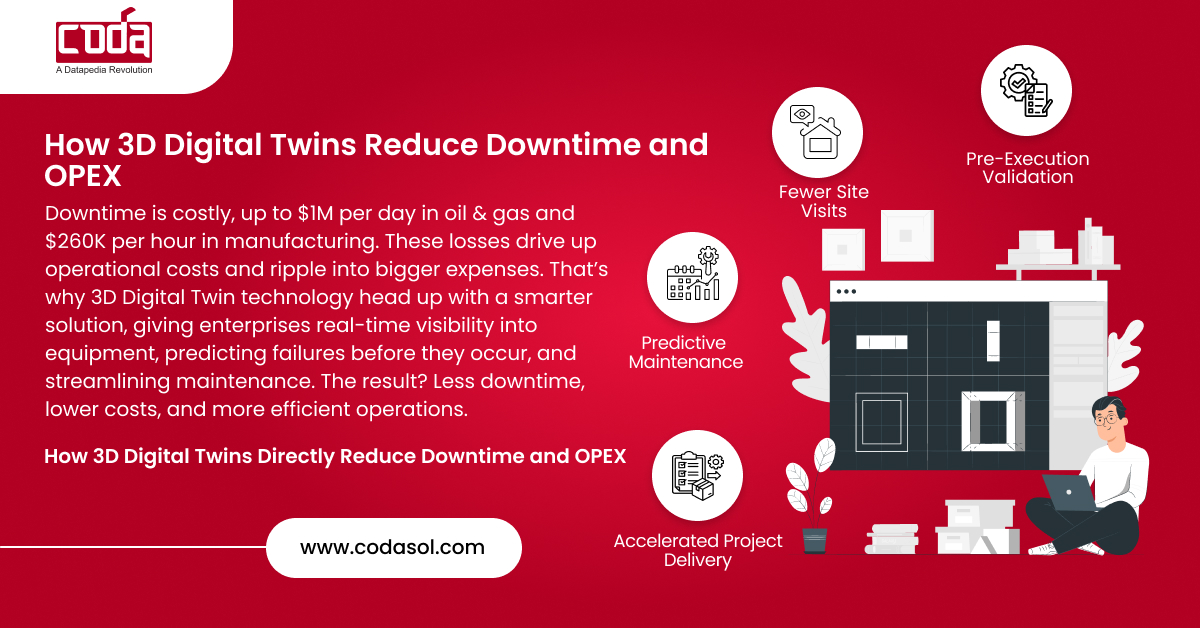Simulate Before You Spend: How 3D Digital Twins Reduce Downtime and OPEX
Every day a critical asset is offline, you’re not just losing production; you’re losing profit. In oil & gas, downtime can cost upwards of $1 million per day. In manufacturing, the average is $260,000 per hour. For utilities, even a single outage can erode customer trust and trigger regulatory scrutiny.
Yet, capital projects, retrofits, and maintenance shutdowns still rely heavily on manual measurements, outdated drawings, and “best guess” planning. This will cause cost overruns, delayed schedules, and avoidable operational risks. 3D digital twins change that. They allow you to simulate asset changes, validate designs, and identify risks before you commit to spend.
What Exactly Is a 3D Digital Twin?
A 3D digital twin is an exact, engineering-grade virtual replica of your asset, created through high-precision scanning technologies such as laser and borescopic inspection.
Unlike traditional CAD models or static diagrams, a digital twin:
- Represents real-world geometry with sub-millimeter accuracy
- Can simulate operational changes before they occur
- Integrates with your ERP, EAM, or asset management systems
- Provides a single source of truth for engineering, operations, and maintenance
Downtime and Escalating OPEX
Downtime is not a cost you “absorb.” It’s a cost that compounds, impacting revenue, resource allocation, and reputation.
OPEX leakage often comes from:
- Unplanned shutdowns caused by avoidable errors
- Spare parts ordered reactively (often at premium pricing)
- Extended contractor time on site
- Asset replacements scheduled earlier than necessary
This operational model is reactive by design. Digital twin–driven simulation turns it into a proactive one.
How 3D Digital Twins Directly Reduce Downtime and OPEX
1. Pre-Execution Validation
Run “what-if” scenarios before a wrench is turned:
- Will the new compressor fit existing connections?
- Can a heat exchanger be replaced without removing adjacent piping?
- What clearance issues will impact maintenance schedules?
By detecting these issues virtually, you avoid on-site surprises.
2. Fewer Site Visits
Remote planning using a validated digital twin reduces physical inspections, safety risks, and mobilization costs critical for offshore, hazardous, or remote environments.
3. Predictive Maintenance
When integrated with IoT data, digital twins provide early failure warnings, allowing maintenance to be scheduled during planned outages.
4. Accelerated Project Delivery
Simulations streamline stakeholder alignment and engineering sign-offs, enabling faster decision-making and fewer design revisions.
Case Example:
A leading GCC petrochemical plant engaged CODA to prepare for a high-value compressor overhaul.
Our team:
- Scanned the asset with sub-millimeter accuracy
- Created a simulation-ready 3D twin with clash detection
- Identified two clearance conflicts that would have delayed reassembly
Impact:
- Prevented a 9-day outage worth $4.5M in lost production
- Reduced contractor presence on site by 18%
- Delivered validated CAD and BOM directly into the client’s ERP
Implementation Framework: Deploying a Digital Twin Strategy
Step 1: Prioritize High-Impact Assets
Focus on those with the highest downtime cost or maintenance complexity.
Step 2: Capture Reality Data
Leverage laser scanning, drone mapping, and borescopic inspection for complete geometry capture—even in inaccessible areas.
Step 3: Create the Digital Twin
Convert scan data into engineering-grade deliverables:
- Mesh models (STL, OBJ) for visualization
- Parametric CAD (STEP, IGES) for integration
- BOM and PMI data for manufacturing and procurement
Step 4: Simulate and Optimize
Run operational, spatial, and safety simulations before execution.
Step 5: Integrate and Maintain
Connect the twin to your asset management system and update after every modification to retain accuracy over time.
Traditional vs. Digital Twin Planning
| Feature | Traditional Planning | 3D Digital Twin Planning |
|---|---|---|
| Data Accuracy | Manual / outdated drawings | Sub-millimeter scan accuracy |
| Clash Detection | Post-installation | Pre-installation |
| Downtime Risk | High | Minimized |
| Planning Duration | Weeks to months | Days to weeks |
| OPEX Predictability | Reactive | Proactive |

Schedule a Consultation
Discuss your highest downtime challenges and see how simulation can cut your OPEX.
ROI Rationale: Why CFOs Approve It
Digital twin implementation delivers returns in months, not years. Typical value drivers include:
- Avoided downtime — a single prevented clash can offset the project cost
- Reduced material waste — accurate measurements mean precise orders
- Lower contractor hours — less on-site troubleshooting
- Improved safety — fewer unplanned interventions in hazardous zones
Why CODA Leads in Industrial Digital Twins
CODA’s proven approach delivers:
- Engineering-grade accuracy with advanced scanning methods
- End-to-end workflow from capture to ERP integration
- Industry-specific compliance for Oil & Gas, Utilities, EPCs, and Manufacturing
- Traceable documentation for audits, training, and lifecycle management
We don’t stop at creating a model. We deliver an actionable, validated dataset that drives operational and financial outcomes.
Common Implementation Pitfalls to Avoid
Even with the right technology, execution missteps can erode ROI:
- Scanning assets after major design decisions are already made
- Excluding maintenance teams from simulation reviews
- Failing to enforce a standard for documentation deliverables
- Not updating the twin after modifications leading to data drift
Request a Cost-Savings Assessment
Our engineers will model your downtime risks and show you the ROI potential.

FAQ: 3D Digital Twins for Asset-Intensive Enterprises
1. How accurate is a 3D digital twin?
With CODA’s methods, accuracy is sub-millimeter, validated through manual QA.
2. Can assets be scanned while operational?
Yes. We use non-contact methods suitable for live and hazardous environments.
3. How quickly can a digital twin be delivered?
Most single-asset projects are delivered in 7–14 days.
4. Is this only relevant for large plants?
No. We deliver value for both individual high-value assets and multi-facility portfolios.
5. Can CODA’s output integrate with SAP or Maximo?
Yes, our deliverables are optimized for leading ERP and EAM systems.

Available now on the SAP Store
PROSOL integrates directly with your SAP systems to deliver golden records at scale.

